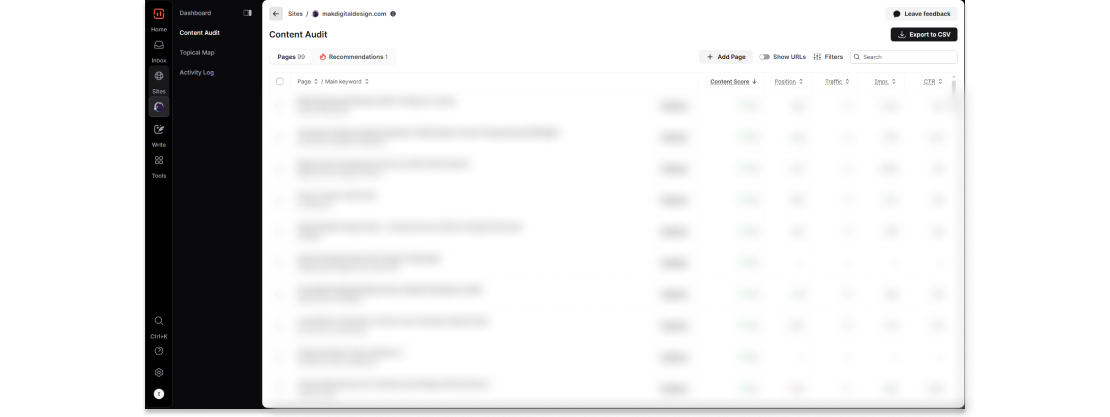
Content marketing plays a huge role in the success of any eCommerce business. Especially for smaller brands trying to compete with more established players, it offers a way to gain visibility and trust. If you’re a small to mid-sized business, your content can be one of your biggest assets but only if it’s actually working for you.
The problem isn’t always a lack of content. More often, it’s that the content hasn’t been maintained, updated, or checked for quality. Many brands continue to push out blog posts, landing pages, and product descriptions without asking the right questions. For example: Is this still accurate? Is it driving traffic? Is it helping convert visitors into customers?
That’s where a content audit comes in. In a market where search visibility, credibility, and customer trust are everything, auditing your content helps ensure what you’ve already created is working as hard as it should be. It’s not about starting over. Rather, it’s about strengthening what you already have.
If it’s been a while since you reviewed your site’s content, now is the time to take a closer look. In this blog, we’ll walk through what a content audit is, why it matters, what to look for, and how to do it without getting overwhelmed. Keeping your content sharp is one of the smartest moves you can make. We’ll show you how to do it right.
What Is a Content Audit?
A content audit is the process of reviewing all of your existing website content to evaluate its quality, accuracy, relevance, and performance. For eCommerce businesses, this includes everything from blog posts and product descriptions to landing pages, FAQs, and even older promotional content. The goal is to identify what’s helping your business and what might be holding it back.
Ask yourself: Is the content driving traffic? Does it reflect your current products, services, and tone? Most importantly, is it useful to your customers? These are critical questions every audit should answer.
This process isn’t just about improving SEO rankings. It’s also about enhancing the overall customer experience. High-quality content builds trust, answers real questions, and moves people closer to a purchase. On the flip side, outdated or weak content can hurt your credibility and drive potential customers away.
A strong content audit helps you clean up what’s broken, sharpen what’s working, and uncover opportunities your existing content may be missing. That way, your content works harder for your business.
Why It Matters for Small and Mid-Sized Brands

For small and mid-sized eCommerce businesses, content can be a powerful equalizer but only if it’s kept up to date. Stale or outdated content doesn’t just sit quietly in the background. It actively works against you by hurting your search rankings, eroding credibility, and making your site feel neglected.
When visitors land on a page with outdated information or poor formatting, it sends a message that your business isn’t paying attention. That’s not the impression you want to give.
Search engines like Google now prioritize content that is fresh, accurate, and valuable. If your competitors are keeping their content sharp and relevant while yours remains untouched, they’ll likely rank higher and win more trust from potential customers.
In a crowded market, especially if you don’t have the budget for large ad campaigns, content becomes one of your most cost-effective ways to compete. High-quality content shows authority, builds trust, and turns visitors into buyers. A content audit is the first step to ensuring that every piece is pulling its weight.
What You Should Be Looking For
When conducting a content audit, you’re not just skimming pages for typos. You’re identifying what’s outdated, what’s underperforming, and what no longer fits your brand. One of the first things to check is whether the information is still accurate. Look for old statistics, discontinued products, or broken links that could confuse visitors or harm your SEO.
Next, assess how readable the content is. Long, dense blocks of text, outdated formatting, or missing headings can make even good content difficult to engage with. Clarity and structure go a long way.
You should also identify any duplicate content or pages targeting the same keywords. This can weaken your search rankings and confuse search engines about which page to prioritize. Consolidating overlapping content often strengthens your site.
Finally, ask whether each piece of digital content still aligns with your current products, services, and brand voice. If your business has evolved, your content should reflect that evolution. Thin pages that don’t provide real value or answer common customer questions are better off being updated, merged, or removed altogether. Every page on your site should earn its place.
How to Do a Content Audit Without Getting Overwhelmed
The idea of reviewing all your website content might sound intimidating, but it doesn’t have to be. The key is to start with your most important pages — think high-traffic blog posts, top-selling product pages, and key landing pages that drive conversions. These are the areas where even small improvements can lead to big results.
From there, use tools like Google Analytics and Search Console to understand what’s performing well and what’s falling flat. For deeper insights, platforms like SEMrush and Surfer SEO are especially useful for analyzing blog content and landing pages, helping you see how your content stacks up against competitors.
To keep everything organized, create a simple spreadsheet to log each page, note what needs to be changed or updated, and track your progress as you go. You don’t need to tackle everything at once. Focus first on the content that has the most potential to bring fast results — whether that’s fixing an outdated headline on a popular page or refreshing a blog post that’s ranking on page two of search results. Working in phases makes the process more manageable and helps you see early wins that build momentum.
What to Do With the Results
Once your content audit is complete, the real work begins — putting those insights into action. Start by updating content that’s still relevant but outdated. Add fresh statistics, replace low-quality visuals, or rework headlines to make them more compelling.
For pages that aren’t performing well on their own, consider combining them into more comprehensive guides. These guides can deliver greater value to your audience and improve your ranking potential. Sometimes, it’s not about rewriting, it’s about repositioning.
Don’t let strong content go to waste. Repurpose high-performing blog posts into new formats. Turn them into social media posts, email newsletters, or even video scripts to reach wider audiences without starting from scratch.
At the same time, keep an eye out for missing content. Look for questions your customers frequently ask that your current content doesn’t answer. Explore keywords you haven’t targeted yet but should. A solid audit doesn’t just clean up the past, it helps shape a more strategic content plan for the future.
Conclusion
Content audits aren’t just for big brands with massive teams. They’re a practical, high-impact move for any eCommerce business looking to compete in today’s digital landscape. Whether you’re running a small shop or a growing brand, reviewing your content ensures it’s current, helpful, and aligned with your goals.
Guesswork won’t cut it anymore. If you’re unsure which content is supporting your business and which is silently holding it back, a content audit provides the clarity you need to make smart, informed decisions.

 Eashan Mehta
Eashan Mehta






